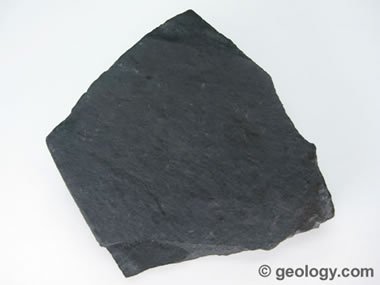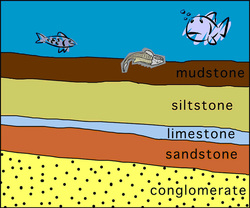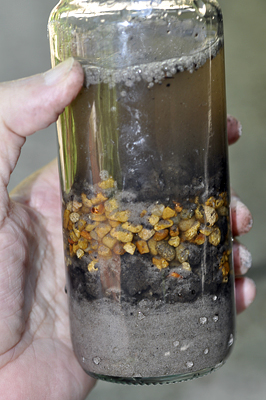Sedimentary Rock Quiz
(288).jpg)
.
- 1.
What changed in the depositional environment to stop making shale and start making siltstone?
- 2.
What sand type pictured below would be deposited when slowly moving water losses energy (slows down a little)?
- A.
Fine sand
- B.
Medium sand
- C.
Coarse sand
- D.
Very coarse sand
Correct Answer
A. Fine sand -
- 3.
What sediment size is smaller than silt?
- A.
Fine sand
- B.
Sand
- C.
Gravel
- D.
Clay
Correct Answer
D. Clay -
- 4.
This Law tells us younger strata (layers) are above older sedimentary strata if the rock is undisturbed.
- A.
Uniformitarianism
- B.
Superposition
- C.
Gravity
- D.
Relativity
Correct Answer
B. Superposition -
- 5.
Fossils form in sedimentary rock. Is it more likely they would occur in
- A.
Breccia
- B.
Conglomerate
- C.
Shale
- D.
Coarse sandstone
Correct Answer
C. Shale -
- 6.
This rock is shale (with a fossil). This originally formed thousands or millions of years ago in a(n)
- A.
Is a fluvial (river) environment were water moves fast
- B.
Where slow moving water entirely stops moving in a delta
- C.
Shallow marine environment
- D.
Open ocean (pelagic)
Correct Answer
B. Where slow moving water entirely stops moving in a delta -
- 7.
Shale and sandstone are 2 examples of
- A.
Clastic sedimentary rock
- B.
Organic sedimentary rock
- C.
Chemical sedimentary rock
- D.
Extrusive igneous rock
Correct Answer
A. Clastic sedimentary rock -
- 8.
This is an evaporated sea that has left halite. This is a ____________ sedimentary rock
- A.
Metamorphic
- B.
Organic
- C.
Chemical (evaporite)
- D.
Clastic
Correct Answer
C. Chemical (evaporite) -
- 9.
Name the rock and what is holding the sediments together.
- A.
Shale; calcite, silt and clay
- B.
Sandstone; calcite, silt and clay
- C.
Sandstone; only silt and clay
- D.
Siltstone; calcite, silt and clay
Correct Answer
B. Sandstone; calcite, silt and clay -
- 10.
This rock is made of clay size sediments held together by calcite and gypsum. Name this rock.
- A.
Siltstone (chemical)
- B.
Siltstone (clastic)
- C.
Shale (chemical)
- D.
Shale (clastic)
Correct Answer
D. Shale (clastic) -
- 11.
Name the sedimentary rock
- A.
Coal
- B.
Limestone
- C.
Gypsum
- D.
Shale
Correct Answer
A. Coal -
- 12.
This is
- A.
Igneous
- B.
Clastic sedimentary rock
- C.
Chemical sedimentary rock
- D.
Organic sedimentary rock
Correct Answer
D. Organic sedimentary rock -
- 13.
What layer is the oldest
- A.
Mudstone (same as shale)
- B.
Conglomerate
- C.
Siltstone
- D.
Sandstone
Correct Answer
B. Conglomerate -
- 14.
A natural levee forms when floods deposit sediments on the river bank. What size sediments would you expect them to be made of? What would be in the flood plain?
- A.
Sand, silt and clay
- B.
Gravel, gravel
- C.
Silt, gravel
- D.
Clay, sand
Correct Answer
A. Sand, silt and clay -
- 15.
This has been shaken and left to settle. True or False
- A.
True
- B.
False
Correct Answer
B. False -
- 16.
After shaken why does clay sediment settle last?
- A.
It is made of quartz
- B.
It is the smallest sediment so it is held by moving water the easiest
- C.
The silt has a negative charge and repels the clay
- D.
Clay is the first to settle
Correct Answer
B. It is the smallest sediment so it is held by moving water the easiest -
- 17.
Why do chemical sedimentary rocks form far out into the ocean?
- A.
There is fast moving water that slows here
- B.
There is no energy/moving water depositing sediments that far out
- C.
There is slow moving water slows even more here
- D.
Large sediments are carried the farthest
Correct Answer
B. There is no energy/moving water depositing sediments that far out -
Quiz Review Timeline +
Our quizzes are rigorously reviewed, monitored and continuously updated by our expert board to maintain accuracy, relevance, and timeliness.
-
Current Version
-
Jun 08, 2021Quiz Edited by
ProProfs Editorial Team -
Oct 29, 2014Quiz Created by
Forddw123
 Back to top
Back to top














